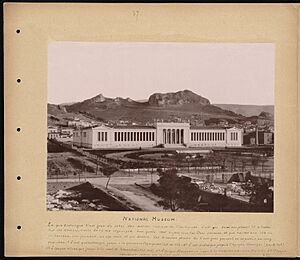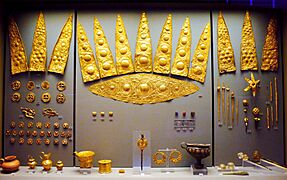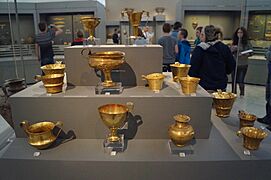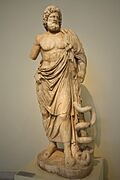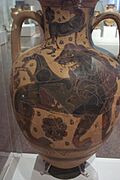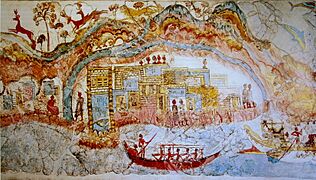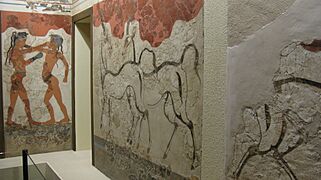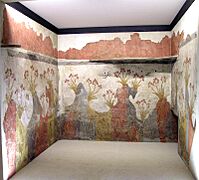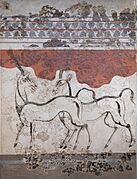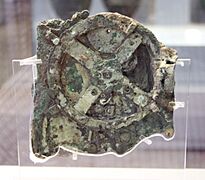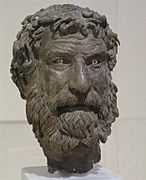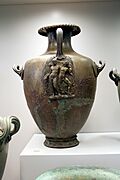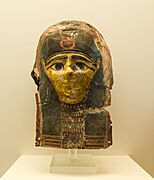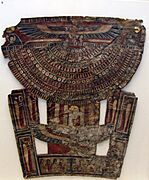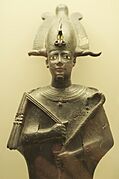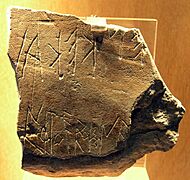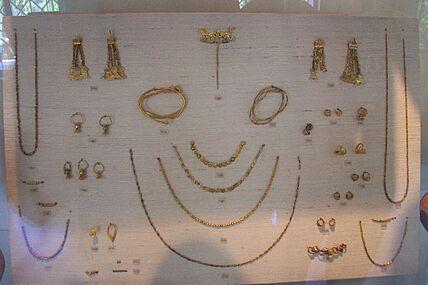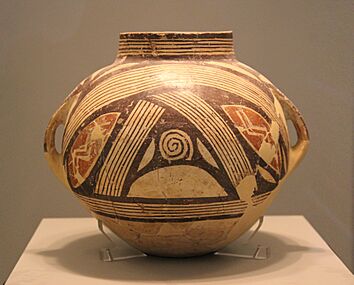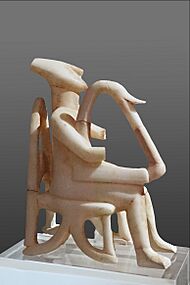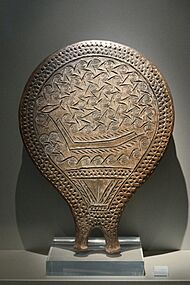National Archaeological Museum, Athens facts for kids
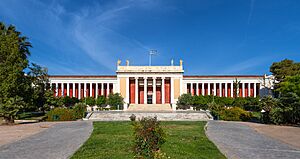
Façade of the National Archaeological Museum, Athens
|
|
| Lua error in Module:Location_map at line 420: attempt to index field 'wikibase' (a nil value). | |
| Established | 1829 |
|---|---|
| Location | Patission Street, Athens, Greece |
| Type | National museum |
| Public transit access | |
The National Archaeological Museum (Greek: Εθνικό Αρχαιολογικό Μουσείο, romanized: Ethnikó Archaiologikó Mouseío) in Athens, Greece, is a super important place. It is home to some of the most amazing ancient treasures found all over Greece. These items range from prehistoric times all the way to late Roman times. Many people think it is one of the best museums in the world. It has the biggest collection of ancient Greek items anywhere! You can find it in central Athens, on Patission Street. It is right next to the old building of the National Technical University of Athens.
Contents
History of the Museum
The very first national archaeological museum in Greece started way back in 1829. It was created by Greece's leader, Ioannis Kapodistrias, in a place called Aigina. Later, the ancient items were moved around to different places until 1858. That year, a contest was held to design a brand new museum building.
The spot where the museum stands today was chosen. Building started in 1866 and finished in 1889. Money for the building came from the Greek Government, the Greek Archaeological Society, and a group from Mycenae. Two very important helpers were Eleni Tositsa, who gave the land, and Demetrios and Nikolaos Vernardakis, who gave a lot of money.
The museum was first called The Central Museum. In 1881, the Prime Minister, Charilaos Trikoupis, changed its name to what it is today. In 1887, a famous archaeologist named Valerios Stais became the museum's curator. This means he was in charge of the collections.
During World War II, the museum had to close. All the ancient items were carefully sealed in special boxes and buried. This was done to keep them safe from being destroyed or stolen. In 1945, the museum reopened, and the exhibits were put back on display. The south part of the museum holds the Epigraphical Museum. This museum has the world's largest collection of ancient writings carved into stone. This part of the museum grew bigger between 1953 and 1960.
The Museum Building
The museum building looks very grand with its neo-classical design. This style was very popular in Europe at the time. It also fits well with the ancient Greek items inside. The first idea for the building came from architect Ludwig Lange. Later, Panagis Kalkos changed the plans and became the main architect. Other architects, Armodios Vlachos and Ernst Ziller, also helped. In front of the museum, there is a large neo-classic garden. This garden is decorated with beautiful sculptures.
Museum Upgrades and Changes
The museum building has been made bigger many times. A new east wing was added in the early 1900s. This was based on plans by Anastasios Metaxas. Also, a two-story building was added between 1932 and 1939, designed by George Nomikos. These additions were needed because the collection of ancient items was growing very fast.
The museum had a big makeover that took more than 1.5 years. During this time, it was completely closed. It reopened in July 2004, just in time for the Athens Olympics. This makeover made the building look better and work better. It got a new air-conditioning system. The museum's collection was also reorganized. Damage from an earthquake in 1999 was fixed. The rooms showing ancient Minoan frescoes opened in 2005. In May 2008, new collections of Egyptian antiquities and items from Eleni and Antonis Stathatos were opened.
In 2020, people started talking again about making the museum even bigger. A new plan was made for an underground addition in front of the museum. In 2023, the Greek government approved plans for a 20,000 square meter underground extension. This extension is expected to be finished by 2028. It will also have a garden on its roof.
Museum Collections
The museum's collections are organized into different sections:
| Collections | ||
|---|---|---|
| Section | Rooms | Sample items |
| Prehistoric Collection (Neolithic, Cycladic, Mycenaean) |
3–6 and 48 |
|
| Sculptures Collection | 7–34 |
|
| Vase and Small Objects Collection | 42 and 49–56 |
|
| Santorini Collection | 48 | |
| Metalwork Collection | 36–39 |
|
| Egyptian and Near Eastern Antiquities Collection | 40–41 |
|
| Epigraphical Museum | 1, 9 & 11 |
|
Prehistoric Treasures
The prehistoric collection shows items from the Neolithic era (6800–3000 BC), and the early and middle Bronze Age (3000–2000 BC and 2000 to 1700 BC). It also includes items from Cycladic and Mycenaean art.
Neolithic and Early Bronze Age Finds
You can see pottery from important Neolithic sites like Dimini and Sesclo. There are also middle Helladic pottery pieces from places like Boeotia and Attica. Some items found by Heinrich Schliemann in Troy are also on display. Some cool things in this collection include:
Cycladic Art Collection
The Cycladic collection has famous marble figures from the Aegean Islands of Delos and Keros. One special piece is the Lutist. These mysterious human figures look a bit like modern art. They inspired many artists, like Henry Moore. They came from 3,000-year-old cemeteries on the Aegean islands. Bronze tools and containers were found with them.
Mycenaean Art Collection
The Mycenaean civilization is shown through stone, bronze, and ceramic pots. There are also figures, ivory, glass, and faience objects. You can see golden seals and rings from tombs in Mycenae and other places. These places include Tiryns and Dendra in Argolis, Pylos in Messinia, and Vaphio in Lakonia. Two golden cups from Vafeio are very interesting. They show a scene of catching a bull.
Heinrich Schliemann's Discoveries
The Mycenaean collection also includes amazing finds from the 1800s by Heinrich Schliemann. He found them in Mycenae at Grave Circle A and the older Grave Circle B. The most famous are the golden funeral masks. These masks covered the faces of important Mycenaean nobles. The most well-known is mistakenly called the mask of Agamemnon. You can also see items from the citadel of Mycenae. These include carved stones, golden containers, and tools and jewelry made of glass, alabaster, and amber. Other cool items are an ivory carving of two goddesses with a child. There is also a painted limestone head of a goddess and the famous warrior's vase from the 12th century BC.
Ancient Egyptian Art
The Egyptian collection started in the late 1800s. The Egyptian government gave nine mummies from the time of the Pharaohs in 1893. However, most of the Egyptian collection came from two donors: Ioannis Dimitriou (in 1880) and Alexandros Rostovic (in 1904). In total, the collection has over 6,000 items. About 1,100 of these are currently on display for everyone to see. This collection is thought to be one of the best collections of Egyptian art in the world.
The exhibit shows rare statues, tools, jewelry, and mummies. There is a wooden tag for a mummy and a beautiful bronze statue of a princess. You can also see intact bird eggs and a 3,000-year-old loaf of bread with a bite missing! The main attraction is a bronze statue of the princess-priestess Takushit. It dates back to around 670 BC. The statue is 70 cm tall and wears a dress covered in hieroglyphs. It was found south of Alexandria in 1880.
Stathatos Collection
The Stathatos collection is named after the generous donors, Antonis and Eleni Stathatos. This collection has about 1,000 items. Most of them are jewels, but there are also metal objects, vases, and pottery. These items range from the Middle Bronze Age to after the Byzantine era. The golden jewels from the Hellenistic period found in Karpenissi and Thessaly are especially notable.
Artists and Artifacts
Some of the ancient artists whose work is shown in the museum include Myron, Scopas, and Euthymides. You can also see works by vase painters like Lydos and Pan Painter.
The collections include many types of items. There are sculptures, and different kinds of ancient Greek pots like Loutrophoros, amphora, Hydria, and Skyphos. You can also see carved stone slabs called stele, colorful frescoes, and beautiful jewelry. Weapons, tools, coins, toys, and other ancient items are also on display.
These amazing artifacts come from archaeological digs in many places. Some are from Santorini, Mycenae, Tiryns, and Dodona. Others are from the Aegean islands, Delos, and the Temple of Aphaea in Aegina. Items also came from the Antikythera wreck and many other sites across Greece.
The museum also has the ancient terracotta statuette called daidala. This statuette inspired the designers of the mascots for the 2004 Athens Olympics, Athena and Phevos.
Newest Exhibits
Two of the newest items in the museum are a golden funeral wreath from the 4th century BC and a marble statue of a woman from the 6th century BC. These items were stolen and then returned to Greece in 2007. They came from the J. Paul Getty Museum in Los Angeles. This happened after a 10-year legal fight between the Getty Center and the Greek Government.
One year before that, the Getty foundation agreed to return a 4th-century BC tombstone from near Thebes. They also returned a 6th-century BC relief from the island of Thassos.
Museum Highlights
- Antikythera Ephebe
- Antikythera mechanism
- Aphrodite of Syracuse
- Apollo Omphalos
- Armed Aphrodite
- Artemision Bronze
- Atalante Hermes
- Bronze statuettes of athletic Spartan girls
- Bust of Antinous
- Capitoline Venus
- Daidala
- Diadumenos
- Dipylon inscription
- Funerary naiskos of Aristonautes
- Funerary Stela of Demokleides
- Great Eleusinian Relief
- Group of Aphrodite, Pan and Eros
- Heracles of Antikythera
- Hermes Criophorus
- Hermes of Aegium
- Jockey of Artemision
- Kouroi and Korai:
- Kroisos Kouros
- Merenda Kouros
- Phrasikleia Kore
- Sounion Kouros
- Lemnos stela
- Lenormant Athena
- Lycosoura Artemis
- Lycosoura Demeter
- Mantineia Base
- Marathon Boy
- Mask of Agamemnon
- Mycenean Warrior Vase
- Nestor's Cup
- Nike of Epidaurus
- Nike of Megara
- Ninnion Tablet
- Pitsa panels
- Poseidon of Melos
- Rhyton in the shape of a bull head
- Theseus Ring
- Varvakeion Athena
- Wall frescoes from Tiryns and Santorini
Library of Archaeology
The museum has a very old library, over 118 years old! It is full of rare books and publications about ancient art, science, and philosophy. The library has about 20,000 books, including some very old ones from the 1600s. The books cover topics like archaeology, history, arts, ancient Greek religion, and ancient Greek philosophy. They also include ancient Greek and Latin literature. The diaries from various archaeological digs, including those of Heinrich Schliemann, are very special. This collection of archaeology books is the best of its kind in Greece. The library was recently updated with money from the Alexander S. Onassis Foundation. Its renovation finished on May 26, 2008, and it is now named after Alexander Onassis.
Museum Activities
- The museum has special labs to help preserve ancient items.
- It has a photo archive and chemistry labs.
- The museum puts on special exhibits both inside the museum and in other countries.
- It hosts many talks about archaeology in its lecture hall every year.
How to Visit
You can easily get to the museum using the Athens Metro. The closest station is Victoria Station (Line 1), which is only a 5-minute walk away. The museum has a gift shop where you can buy copies of artifacts. There is also a café in the sculpture garden. The museum is fully accessible for wheelchairs. It also has facilities and guides for visitors who are hearing-impaired. It is next to the old building of the National Technical University. You can also reach it by bus and trolleybus.
See also
- Ancient Greek art
- Ancient Greek sculpture
- Ancient Greek technology
- Gorgons
- Greek terracotta figurines
- Kouros
- List of museums in Greece
- List of museums of Greek and Roman antiquities
- Pottery of ancient Greece
- Typology of Greek vase shapes


